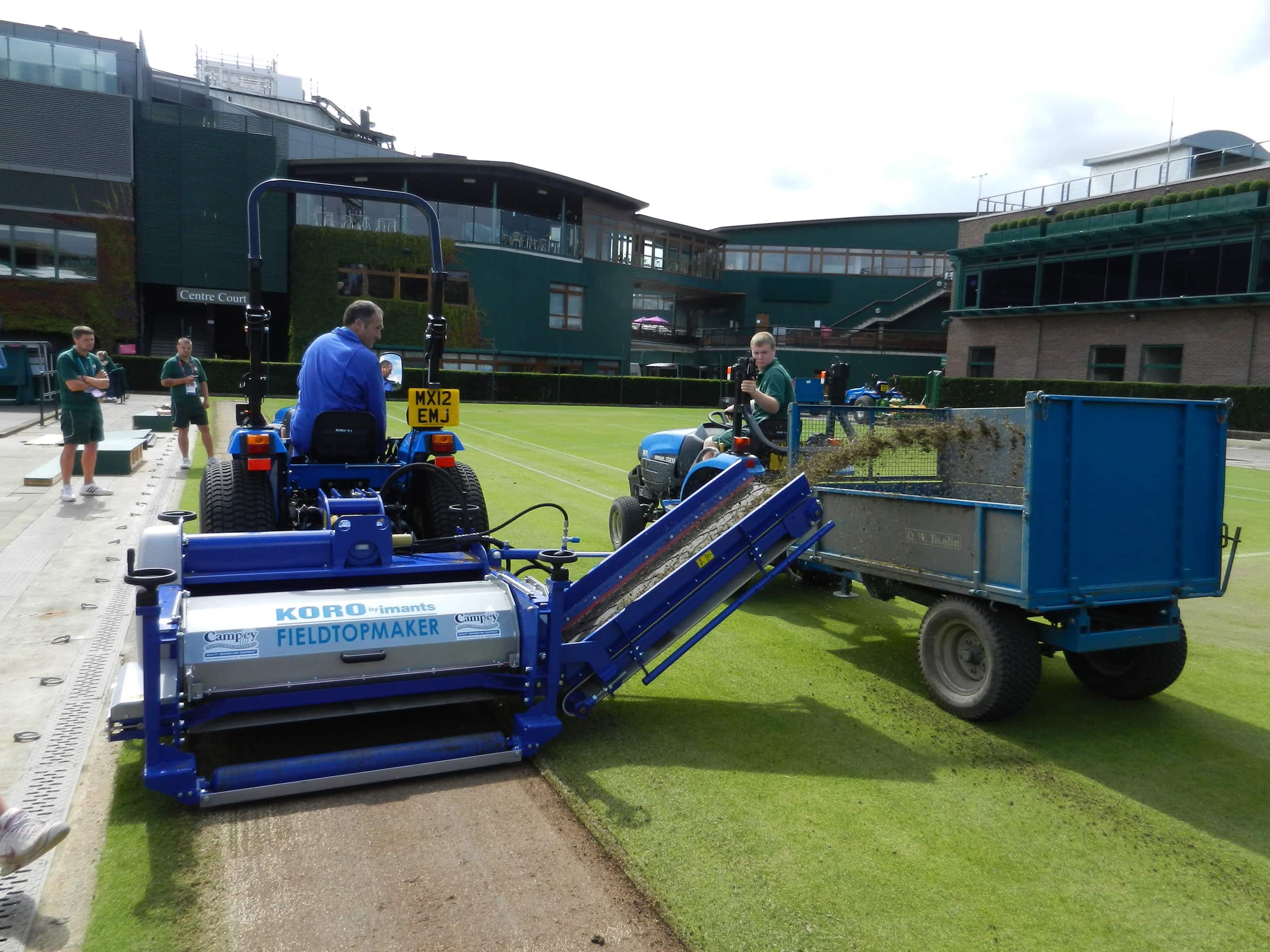…The wrong type of grass invaded the courts in the Nineties — Poa annua is a coarse grass that causes lumps, bumps and brown patches. Nowadays it is largely removed by a special machine, the Koro Field Top Maker, that also shaves and planes the grass. It’s a little pricey for your average suburban lawn, though, starting at £12,000.
Night and day, it has a small army tending to it. It’s trimmed and tonsured daily to ensure it is exactly the right length, the perfect hue and is neither too lush nor too dry, and never greasy.
No, not the Duchess of Cambridge’s hair, but an organism whose colour and luxuriance is — for a fortnight at least — even more closely scrutinised: the Wimbledon grass.
Head groundsman Neil Stubley is to the sacred turf of Centre Court what hairdresser Richard Ward is to Kate’s hallowed hair.
For Stubley and his team, it’s a year-round job keeping each blade of grass in perfect health, ready for when the eyes and cameras of the world — not to mention the size 12 tennis shoes of Murray and Co — are on it.
So what does wet weather mean for the Wimbledon grass? What role does the Billy Goat play? And why are hawks flown and hammers thrown on Centre Court?
Such is the level of dedication that goes into preparing the surface that the day after the Wimbledon trophies are handed out, ground staff start preparing for next year. They shave the grass down to the ground, which removes all the weak and weedy grasses.
The ground is then levelled off with six tonnes of new soil on each court to make sure the surfaces are completely level after the wear and tear of the tournament fortnight, and to give the new grass fresh soil in which to grow.
In the winter, the grass is cut to a height of 13mm, but from the end of March the length is reduced by a millimetre a week with a precision trimmer until it reaches the perfect playing length of 8mm in early May. It then gets cut three times a week until the tournament starts, after which it is cut daily.
Perennial ryegrass is used on the courts as it is tough and durable. Every court has a mixture of three sub-species of ryegrass. Each species has to go through an SAS selection-style trial at the Sports Turf Research Institute in Yorkshire.
Over eight years, hundreds of possibles are whittled down to half-a-dozen contenders. They are then tested on the practice courts.
A machine with a grass court tennis shoe attached to it is run over them for two weeks to simulate the wear and tear of Wimbledon fortnight. Only the super-grasses will survive.
Wimbledon is to grass what football tournaments are to managers — if any of the three sub-species of grass on each court fails to perform it is dropped and won’t return to Wimbledon.
Like the players, the grass needs a daily fitness check to see if its nutrient levels are healthy and it also gets a massage with a roller. Nitrogen levels are monitored: if they get too high, the grass becomes too lush and slippery.
Nearer the tournament, the level of nitrogen in the fertiliser is reduced but the grass is kept green by upping the iron content if necessary. Chlorophyll levels are also measured — if they fall it means the grass is ‘stressed out’ and won’t recover well.
Grass mustn’t get greasy so conditioning is vital. When the roof goes over Centre Court, four air conditioners suck excess moisture out of the air before it can affect the grass. ‘Moisture on the plants is a no-no,’ says head groundsman Neil Stubley.
The question on every keen lawn-proud gardener’s lips: how do you get the stripes on court so straight and perfectly contrasting? By mowing in the same direction, month after month, so the roller folds the blades forward one way — and then the other on the next stripe. They don’t use a ruler, though, just skill and practice.
Hammer-throwing might not seem suited to genteel Wimbledon, but it’s vital. From ten days before it starts, the ground’s hardness is measured daily with a Clegg soil impact hammer.
Costing about £2,000, it looks like a large bicycle pump, with a hammer attached to a digital control unit. The hammer is dropped down a big tube onto the ground. The digital display records the level of impact. If it’s not hard enough, the watering will be reduced. If it’s too hard, then more water is needed.
Billy the Goat helps maintain the courts by gobbling up the dust and loose grass scuffed up by players’ feet. Sadly, Billy is not an actual goat, but a powerful vacuum. Yes, they literally Hoover the courts!
The wrong type of grass invaded the courts in the Nineties — Poa annua is a coarse grass that causes lumps, bumps and brown patches. Nowadays it is largely removed by a special machine, the Koro Field Top Maker, that also shaves and planes the grass. It’s a little pricey for your average suburban lawn, though, starting at £12,000.
Outfoxing the urban fox is essential, as its urine burns the grass. A brown patch appeared overnight on centre court on the eve of one final in the Nineties. The courts are now surrounded with electric wire weeks before the event, and the perimeter patrolled by guard dogs at night.
Pigeons are pests: Sulphur in their droppings burns the grass and they’re partial to pecking grass seed — so a pair of Harris hawks named Rufus and Pollux patrol the skies from 5am-9am to deter them.
Rufus is a veteran of nine years at Wimbledon — he has his own Twitter account (@RufusTheHawk) — but for Pollux, aged two, it’s the first championships.
The newbie is, however, obsessed with players’ balls and keeps pouncing on the yellow Slazengers. He also likes landing on broadcasters’ sound equipment — mistaking the furry booms for rabbits.
Floods haven’t affected the grass, because at the first hint of rain, the courts are covered with inflatable domes. The rain runs off them into the drains. The courts can be covered within 30 seconds.
In 2013, several players complained about slippery grass. Some turf experts said a wet winter and late spring meant that the grass was full of the natural compound sucrose, which made it more moist than usual, though Neil Stubley dismisses this.
What would today’s authorities have made of Maud Watson, who in 1884 won the first Ladies Singles wearing high heels — disastrous for grass — and a hat and bustle?
Read this article on the Daily Mail Online : http://www.dailymail.co.uk/news/article-3672905/Wimbledon-s-perfect-grass-s-secret-Hoovering.html#ixzz4DRjz24eE


